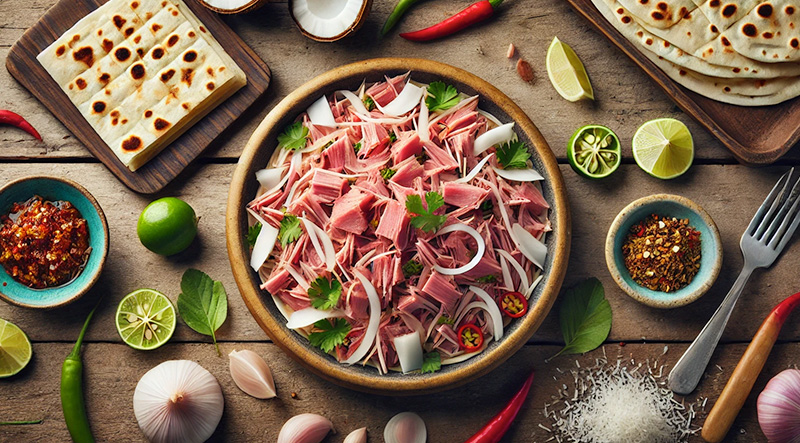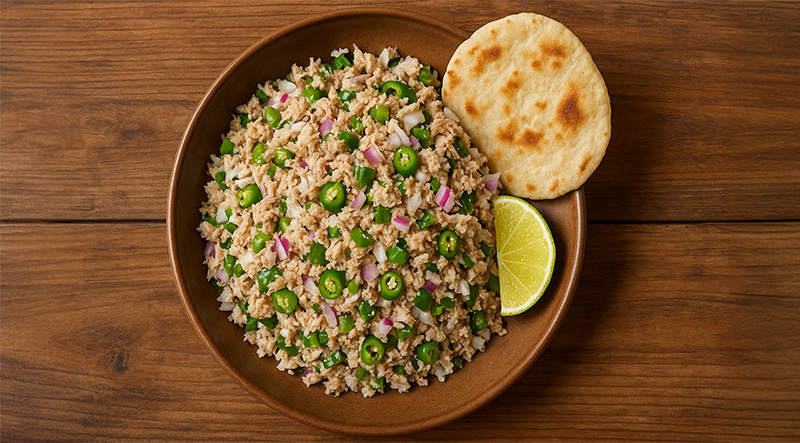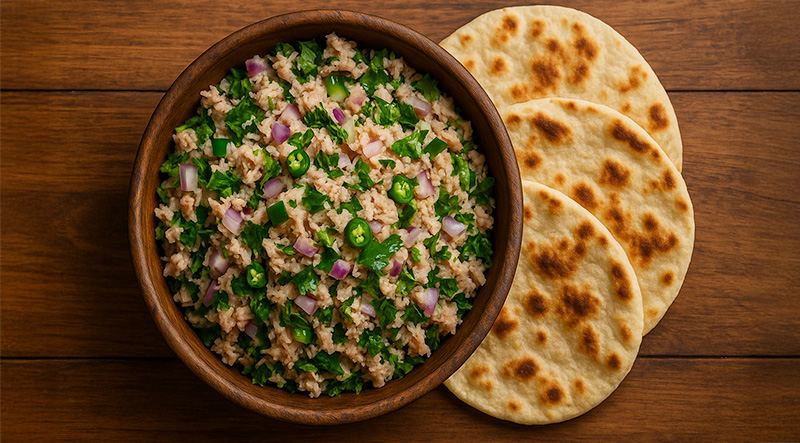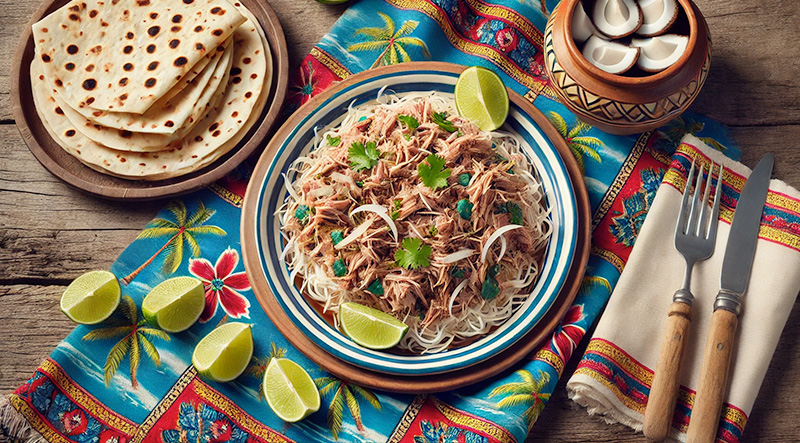Mas Huni is the Maldives on a plate—fresh, zesty, and full of island flavor. Flaky smoked tuna, creamy grated coconut, fiery green chilies, and crisp red onions come together in this popular breakfast dish to create a vibrant combination that is as cool as the sea breeze. Mas Huni, which is traditionally consumed with warm, soft roshi (Maldivian flatbread) and a squeeze of lime, is a light yet filling breakfast that is full of heat, texture, and the essence of the sea. Read More...
The History of Mas Huni – The National Dish of the Maldives:
Tuna, coconut, chili, and tradition—these are the building blocks of Mas Huni, the beloved national dish of the Maldives. A breakfast staple across the archipelago, Mas Huni is a simple yet vibrant mix of shredded smoked tuna, grated coconut, onions, and chilies, served with soft roshi flatbread. It’s not just a dish—it’s a reflection of the Maldivian way of life, deeply tied to the sea, the island’s resources, and the rhythms of coastal living.
Born from the Sea:
Mas Huni’s origins are inseparable from the oceanic lifestyle of the Maldives, a nation of over 1,000 coral islands scattered across the Indian Ocean. For centuries, Maldivians have relied on the sea not just for food, but for culture, economy, and survival. Tuna—particularly skipjack tuna (katsuwo)—has been the lifeblood of the Maldivian diet. Caught in abundance and preserved through traditional smoking or sun-drying, tuna became the foundation of many local dishes.
Mas Huni evolved as a practical way to use preserved tuna in a flavorful, nutritious meal that could be prepared quickly using local, non-perishable ingredients. Its name comes from two Dhivehi words: “mas” meaning fish and “huni” meaning mixture—aptly describing its simple composition.
Coconut and Community:
Alongside tuna, coconut plays a starring role. Coconut palms grow abundantly throughout the Maldives and are used in nearly every aspect of island life—from construction to cuisine. Grated fresh coconut adds a creamy, slightly sweet contrast to the salty tuna and spicy green chili in Mas Huni. This balance of bold and mild is at the heart of Maldivian flavor.
Traditionally, Mas Huni is eaten first thing in the morning, shared with family members gathered around a low table. It’s often served with roshi (similar to roti) and hot black tea, making it a comforting and communal meal.
Simplicity, Sustainability, and Tradition:
One of the reasons Mas Huni has endured for generations is its simplicity and sustainability. With only a few ingredients, most of which are grown or caught locally, the dish is eco-friendly and requires no refrigeration or elaborate cooking methods—qualities that made it ideal for island life long before modern conveniences.
Historically, women would wake before sunrise to prepare Mas Huni while the men returned from early-morning fishing trips. The freshly caught or smoked fish would be shredded and mixed with grated coconut and seasoning by hand. This process, passed down through generations, became part of Maldivian culinary heritage and domestic culture.
Modern Mas Huni:
Today, Mas Huni continues to be a beloved part of the Maldivian diet, but it has also evolved. While the classic version remains popular, variations now include additions like lemon juice, curry leaves, or even eggs and vegetables. In resorts and restaurants, Mas Huni is often presented in more elaborate forms, but its essence remains unchanged.
The dish is not just found in homes but also in hotel buffets, cafés, and island guesthouses—offering tourists a flavorful introduction to local life. Its popularity has even spread to Maldivian communities abroad, where it serves as a nostalgic taste of home.
Conclusion: A Taste of Island Identity:
Mas Huni is more than just breakfast; it’s a bite of Maldivian identity. With its roots in the ocean and its heart in the community, it represents the nation’s resourcefulness, cultural pride, and deep connection to the sea. Whether served in a luxury resort or a humble island kitchen, Mas Huni continues to be a dish that unites Maldivians across generations and geographies—one flaky, spicy, coconut-rich bite at a time.
Prepare the Tuna:

Mix the Ingredients:

Season:


Tips:
Mas Huni is a dish that delivers ocean-fresh flavor with minimal effort—a perfect way to bring the taste of the Maldives to your morning table.
The total preparation time for Mas Huni is approximately **15 to 20 minutes**, as the dish requires no actual cooking. This includes around **5–10 minutes** to flake the tuna and chop the onions, chilies, and any optional ingredients, followed by another **5–10 minutes** to mix everything together and season. If you're also making fresh *roshi* (flatbread) from scratch, allow an additional **20–30 minutes**, but with pre-made or store-bought flatbread, Mas Huni comes together quickly for a fast, flavorful meal.
A single serving of Mas Huni, based on the provided recipe (serving 4), contains approximately **250–300 calories**. This includes about 120–150 calories from the smoked or canned tuna, 100 calories from the grated coconut, and around 30–50 calories from the onions, chilies, and lime juice. If optional ingredients like chopped egg or tomato are added, it may add another 30–60 calories. When served with one piece of *roshi* (flatbread), you can add approximately 120–150 calories more, bringing the total to **370–450 calories** per serving with bread.







